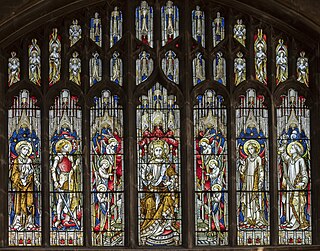
Hardman & Co., otherwise John Hardman Trading Co., Ltd., founded 1838, began manufacturing stained glass in 1844 and became one of the world's leading manufacturers of stained glass and ecclesiastical fittings. After the doors closed at Lightwoods Park Justin Hardman, a descendant of John Hardman kept the heart of the studio alive and with the help of chief designer, Artist Edgar JB Phillips they continue to design and manufacture exquisite traditional Hardman stained glass around the world.

Charles Eamer Kempe was a British Victorian era designer and manufacturer of stained glass. His studios produced over 4,000 windows and also designs for altars and altar frontals, furniture and furnishings, lychgates and memorials that helped to define a later nineteenth-century Anglican style. The list of English cathedrals containing examples of his work includes: Chester, Gloucester, Hereford, Lichfield, Wells, Winchester and York. Kempe's networks of patrons and influence stretched from the Royal Family and the Church of England hierarchy to the literary and artistic beau monde.
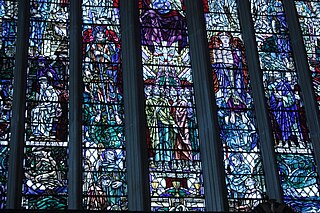
Douglas Strachan is considered the most significant Scottish designer of stained glass windows in the 20th century. He is best known for his windows at the Peace Palace in The Hague, Netherlands, at Edinburgh's Scottish National War Memorial and in cathedrals and churches throughout the United Kingdom. He is also known for his paintings, murals, and illustrations.

William Warrington, (1796–1869), was an English maker of stained glass windows. His firm, operating from 1832 to 1875, was one of the earliest of the English Medieval revival and served clients such as Norwich and Peterborough Cathedrals. Warrington was a historian of medieval glass and published an illustrated book The History of Stained Glass.
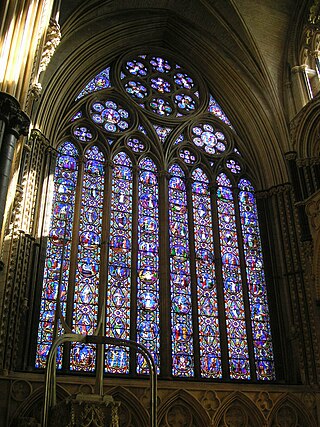
Ward and Hughes was the name of an English company producing stained-glass windows.
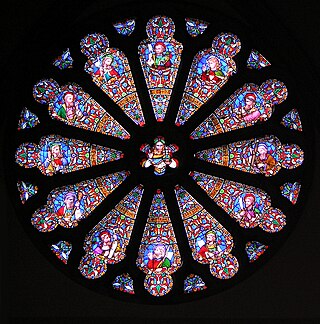
William Wailes (1808–1881) was the proprietor of one of England's largest and most prolific stained glass workshops.

Clayton and Bell was one of the most prolific and proficient British workshops of stained-glass windows during the latter half of the 19th century and early 20th century. The partners were John Richard Clayton (1827–1913) and Alfred Bell (1832–1895). The company was founded in 1855 and continued until 1993. Their windows are found throughout the United Kingdom, in the United States, Canada, Australia and New Zealand.

Heaton, Butler and Bayne was a British firm that produced stained-glass windows from 1862 to 1953.

Arthur Louis Moore was an English glass-maker who specialised in stained glass windows.

Mary Lowndes (1857–1929) was a British stained-glass artist who co-founded the stained glass studio and workshop Lowndes and Drury in 1897. She was an influential leader in the Arts and Crafts movement, not only for her stained glass work and successful studio-workshop, but also for opening doors for other women stained glass artists. She was an active participant in the suffragette movement, acting as Chair of the Artists' Suffrage League, and creating poster art to assist the movement.

William Holland was a 19th-century British maker of stained glass and other decorative pieces. His work is represented in churches and stately homes across England, Wales, and Ireland. Holland of Warwick windows can be identified by his mark "Guil Holland Vaivic. Puix " written on a scroll in Latin in the lower right hand corner. Holland's stained glass reflects the influence of the Cambridge Camden Society and the Gothic Revival work of Thomas Willement. Willement revived in the early 19th century, the method used at York Minster to build the Great East Window in 1400 wherein coloured pieces are leaded and the lead then becomes part of the design, appearing as black lines in the window.
Brian Thomas (1912–1989) was a British artist best known for his decorative work in church buildings, particularly murals and stained glass.
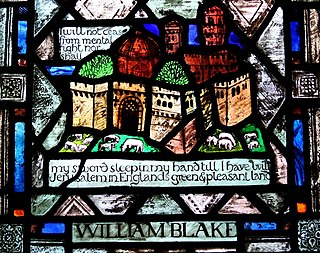
Caroline Charlotte Townshend (1878–1944) was a British stained glass artist of the Arts and Crafts Movement. She trained at Slade School of Fine Art and Central School of Arts and Crafts before becoming a pupil of Christopher Whall. She designed and made many stained glass windows, particularly for churches and cathedrals and set up the stained glass firm of Townshend and Howson in 1920 with her student and apprentice, Joan Howson. They used a dual signature for their completed works.

Walter Percival Starmer (1877-1961) was an English artist, cartoonist, muralist, and stained glass designer.

The Church of St Mary is the Anglican parish church for the town of Bideford in Devon, England. Built in 1865, it replaces a Norman church of 1260. The church has been Grade II* listed by Historic England since 1949 and comes under the Diocese of Exeter.

Goddard & Gibbs was a London-based glassmaker and stained glass window manufacturer. The company was established by Walter Gibbs in 1868, although one firm which it subsequently acquired had been established earlier, in 1855. Goddard & Gibbs was formed by a merger in 1938; the company continued to trade until it was acquired by Hardman & Co. in 2006. Hardman itself ceased to trade in 2008.
Daniel Bell (1840–1915) was a British church decorative artist and sculptor born in Silton, Dorset and died in Willesden.















